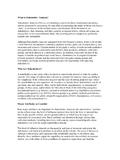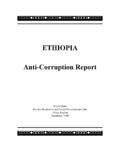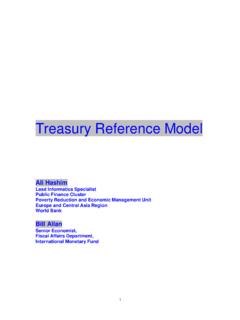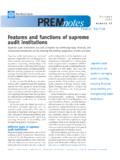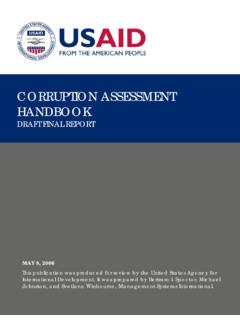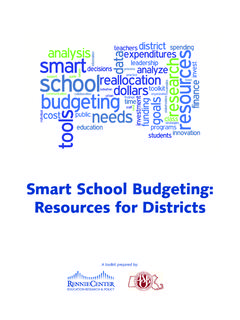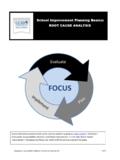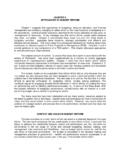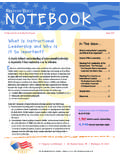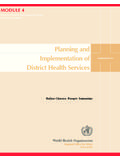Transcription of PUBLIC EXPENDITURE MANAGEMENT HANDBOOK - …
1 PUBLICEXPENDITUREMANAGEMENTHANDBOOKThe World BankWashington, The International Bank for Reconstructionand Development/ THE WORLD BANK1818 H Street, , 20433, rights reservedManufactured in the United States of AmericaFirst printing June 1998 This report is a study by the World Bank s staff, and the judgments madeherein do not necessarily reflect the views of the Board of ExecutiveDirectors or of the governments they 0-8213-4297-5iiiCONTENTSF orewordPART IGUIDELINES FOR IMPROVING BUDGETARY AND FINANCIAL MANAGEMENT INTHE PUBLIC SECTORI ntroduction ..1 Chapter 1 DEVELOPMENTS IN BUDGET PRACTICE .. 11A Historical Perspective on Budget Reform.
2 11 The Way Forward .. 16 Chapter 2 INSTITUTIONAL ARRANGEMENTS FOR BETTER BUDGETARYOUTCOMES .. 17 Balancing Restraint and Flexibility .. 18 Operationalizing the Three Levels .. 26 Chapter 3 LINKING POLICY, PLANNING AND BUDGETING IN AMEDIUM-TERM FRAMEWORK .. 31 Weaknesses that Produce Poor Budgeting Policy, Planning and Budgeting in the Planning andResource MANAGEMENT Sector Level Policy, Planning and Budgeting .. 40 Linking Policy, Planning and Budgeting at theGovernment-wide Level: A Comprehensive Medium-TermExpenditure Framework .. 46 PUBLIC Investment Programs (PIPs) .. 52 Chapter 4 FINANCIAL MANAGEMENT INFORMATION SYSTEMS.
3 59 FMIS Inadequacies .. 60 Institution Building and Policy Reforms .. 61 Developing a Core System .. 61 Integrating Information Systems .. 67 Managing Implementation .. 70 Chapter 5 APPROACHES TO BUDGET REFORM .. 75 Context and Issues in Budget Reform .. 75 Current Initiatives in Budget Reform .. 78 Sequencing of Reform .. 81 Conclusion .. Importance of Different Elements of the InstitutionalFramework at each Level of Budgetary Outcome .. Framework: Authority Delegation .. Policy, Planning and Budgeting in the Planning andResource MANAGEMENT Cycle .. MANAGEMENT : Intervention and Governance.
4 Of the MTEF .. Analysis, Control Framework, and FunctionalProcesses .. Systems Architecture for Government FiscalManagement .. 64 BOXES1 Weaknesses in Resource Allocation and Use ..52 Ten Common (and Questionable) Assumptions aboutBudgeting in Developing Countries ..63 The Characteristics of Budget Systems Requiring Reform ..74 Getting the Basics Right .. Budgeting in Sri Lanka .. in Jamaica .. Projections in the Philippines .. Institutions that Promote Aggregate RestraintHelp Avoid Large Deficits .. between Budgeted and Actual Spendingin Uganda .. Negative Effect of Too Many Centralized Controlsin Ecuador.
5 Code of Good Practices on Fiscal Transparency .. versus Availability .. between Policy Goals and EXPENDITURE Allocationsin Guinea .. Africa s MTEF .. s Mechanisms for Transparent, Competitive andResults-oriented Policy Making .. Journees de Reflexion to an InstitutionalizedConsultation Process .. Zealand s Fiscal Responsibility Act .. First MTEF Experience in Malawi .. Investment Programs (SIPs) .. Agricultural SIP in Zambia .. of Criteria to Apply in Setting Broad ExpenditureAllocations .. Budgeting .. about PIPs .. Emphasis in PIPs .. Investment Programming in Latvia.
6 And Accounting Reform in Transition Economies andDeveloping Countries .. Decision Making in Burkina Faso .. for Strengthening PUBLIC EXPENDITURE MANAGEMENT .. Zealand Reforms Focus on Values and Relationships .. Sector Reform in Mongolia Adopts New Zealand Model .. Indicators and Budgeting .. an Outcome-oriented Budgeting System in Uganda .. : Milestones in Budgeting .. Surveys Enhance Performance Orientation ofPublic Agencies .. to Sound Operational Performance .. PUBLIC MANAGEMENT .. 92 PART IIDiagnosing the Weaknesses and Improving Budgetary and FinancialManagement in the PUBLIC Sector.
7 95 CHECKLISTS OF PRACTICESLaw and Rules .. 96 Budget Coverage and Structure .. 98 Budget Policy and Planning .. 100 Budget Preparation .. 102 Budget Execution .. 104 Aid MANAGEMENT .. 106 Accounting Subsystem .. 108 Auditing System .. 110 Evaluation .. 112 Integrated FMIS .. 114 Performance Measurement .. Questionnaire .. of Budget/Financial MANAGEMENT Practices .. of Key Performance Measurement Terms .. Indicators for PUBLIC Financial MANAGEMENT .. Financing in Malawi .. Australian Experience within a Medium-Term ExpenditureFramework .. Architecture for Government Budgeting and Accounting .. of Functional Requirements for the Budgetingand Accounting Modules of a Government FiscalManagement System.
8 Execution Using Information Systems .. Code of Good Practices on Fiscal Transparency .. 173 This HANDBOOK has evolved over the past two years. It reflects the contributions ofmany people. The HANDBOOK was coordinated by Malcolm Holmes, PRMPS. It drawsheavily on the work of Ed Campos, Sanjay Pradhan, Ali Hashim, and Mike Stevens of theWorld Bank, and Bill Allan of the IMF. Other contributors include Allen Schick,Rob Laking, and Serif Sayin. Research support was provided by Singh andShiro Gnanaselvan. Jane Armitage reviewed an early version of the Kervyn, Helga Muller, and Professor Philip Joyce reviewed the Mendoza, Agnes Yaptenco, and Mariagracia Schierloh provided technical supportand Barbara McGarry Peters edited the HANDBOOK .
9 The report was produced by thePoverty Reduction and Economic MANAGEMENT (PREM) Network of the Bank under theguidance of Cheryl on the HANDBOOK should be addressed to Malcolm Holmes at the WorldBank, 1818 H Street, Washington, 20433; telephone 202-473-7189,fax 202-522-7132, email address Additional material onpublic EXPENDITURE MANAGEMENT , much of it elaborating on and updating material in thehandbook, can be found on the Bank s internal PUBLIC EXPENDITURE web site. This website will be regularly updated and it is intended to make it publicly available in the IGuidelines for ImprovingBudgetary and Financial Managementin the PUBLIC SectorPART IIDiagnosing the Weaknesses and ImprovingBudgetary and Financial Managementin the PUBLIC SectorviiFOREWORDP ublic EXPENDITURE issues are encountered wherever there is a discussion ofgovernment, the PUBLIC sector, and development.
10 Over the years, the World Bank hasinvested considerable resources in analyzing PUBLIC expenditures and the impacts of differentinterventions on sustainable development. This work has both broadened and deepened ourunderstanding of development priorities justifying government HANDBOOK highlights the fact that good analysis and sound policy are not enoughto ensure sound and sustainable development outcomes. As was emphasized in the WorldDevelopment Report 1997: The State in a Changing World, if the institutional arrangements the rules of the game, both formal and informal are not supportive or demanding of goodperformance, the results will not be sustainable on the particular interest is the concept of three levels of budgetary outcomes aggregatefiscal discipline, strategic prioritization (allocative efficiency), and operational performance(technical efficiency).

